[English] 日本語
 Yorodumi
Yorodumi- PDB-7kv8: Chimeric flavivirus between Binjari virus and Dengue virus serotype-2 -
+ Open data
Open data
- Basic information
Basic information
| Entry | Database: PDB / ID: 7kv8 | |||||||||
|---|---|---|---|---|---|---|---|---|---|---|
| Title | Chimeric flavivirus between Binjari virus and Dengue virus serotype-2 | |||||||||
 Components Components |
| |||||||||
 Keywords Keywords | VIRUS / Flavivirus / glycoprotein / entry / fusion | |||||||||
| Function / homology |  Function and homology information Function and homology information: / host cell mitochondrion / symbiont-mediated suppression of host JAK-STAT cascade via inhibition of host TYK2 activity / symbiont-mediated suppression of host JAK-STAT cascade via inhibition of STAT2 activity / symbiont-mediated suppression of host cytoplasmic pattern recognition receptor signaling pathway via inhibition of MAVS activity / ribonucleoside triphosphate phosphatase activity / viral capsid / double-stranded RNA binding / channel activity / viral nucleocapsid ...: / host cell mitochondrion / symbiont-mediated suppression of host JAK-STAT cascade via inhibition of host TYK2 activity / symbiont-mediated suppression of host JAK-STAT cascade via inhibition of STAT2 activity / symbiont-mediated suppression of host cytoplasmic pattern recognition receptor signaling pathway via inhibition of MAVS activity / ribonucleoside triphosphate phosphatase activity / viral capsid / double-stranded RNA binding / channel activity / viral nucleocapsid / monoatomic ion transmembrane transport / clathrin-dependent endocytosis of virus by host cell / methyltransferase cap1 activity / mRNA 5'-cap (guanine-N7-)-methyltransferase activity / RNA helicase activity / protein dimerization activity / symbiont-mediated suppression of host innate immune response / host cell endoplasmic reticulum membrane / symbiont-mediated suppression of host type I interferon-mediated signaling pathway / symbiont-mediated activation of host autophagy / serine-type endopeptidase activity / viral RNA genome replication / RNA-directed RNA polymerase activity / fusion of virus membrane with host endosome membrane / viral envelope / lipid binding / virion attachment to host cell / host cell nucleus / virion membrane / structural molecule activity / proteolysis / extracellular region / ATP binding / metal ion binding / membrane Similarity search - Function | |||||||||
| Biological species |  Dengue virus 2 Dengue virus 2 | |||||||||
| Method | ELECTRON MICROSCOPY / single particle reconstruction / cryo EM / Resolution: 2.5 Å | |||||||||
 Authors Authors | Hardy, J.M. / Venugopal, H.V. / Newton, N.D. / Watterson, D. / Coulibaly, F.J. | |||||||||
| Funding support |  Australia, 1items Australia, 1items
| |||||||||
 Citation Citation |  Journal: Nat Commun / Year: 2021 Journal: Nat Commun / Year: 2021Title: A unified route for flavivirus structures uncovers essential pocket factors conserved across pathogenic viruses. Authors: Joshua M Hardy / Natalee D Newton / Naphak Modhiran / Connor A P Scott / Hariprasad Venugopal / Laura J Vet / Paul R Young / Roy A Hall / Jody Hobson-Peters / Fasséli Coulibaly / Daniel Watterson /  Abstract: The epidemic emergence of relatively rare and geographically isolated flaviviruses adds to the ongoing disease burden of viruses such as dengue. Structural analysis is key to understand and combat ...The epidemic emergence of relatively rare and geographically isolated flaviviruses adds to the ongoing disease burden of viruses such as dengue. Structural analysis is key to understand and combat these pathogens. Here, we present a chimeric platform based on an insect-specific flavivirus for the safe and rapid structural analysis of pathogenic viruses. We use this approach to resolve the architecture of two neurotropic viruses and a structure of dengue virus at 2.5 Å, the highest resolution for an enveloped virion. These reconstructions allow improved modelling of the stem region of the envelope protein, revealing two lipid-like ligands within highly conserved pockets. We show that these sites are essential for viral growth and important for viral maturation. These findings define a hallmark of flavivirus virions and a potential target for broad-spectrum antivirals and vaccine design. We anticipate the chimeric platform to be widely applicable for investigating flavivirus biology. | |||||||||
| History |
|
- Structure visualization
Structure visualization
| Movie |
 Movie viewer Movie viewer |
|---|---|
| Structure viewer | Molecule:  Molmil Molmil Jmol/JSmol Jmol/JSmol |
- Downloads & links
Downloads & links
- Download
Download
| PDBx/mmCIF format |  7kv8.cif.gz 7kv8.cif.gz | 311.8 KB | Display |  PDBx/mmCIF format PDBx/mmCIF format |
|---|---|---|---|---|
| PDB format |  pdb7kv8.ent.gz pdb7kv8.ent.gz | 252.6 KB | Display |  PDB format PDB format |
| PDBx/mmJSON format |  7kv8.json.gz 7kv8.json.gz | Tree view |  PDBx/mmJSON format PDBx/mmJSON format | |
| Others |  Other downloads Other downloads |
-Validation report
| Summary document |  7kv8_validation.pdf.gz 7kv8_validation.pdf.gz | 1.6 MB | Display |  wwPDB validaton report wwPDB validaton report |
|---|---|---|---|---|
| Full document |  7kv8_full_validation.pdf.gz 7kv8_full_validation.pdf.gz | 1.6 MB | Display | |
| Data in XML |  7kv8_validation.xml.gz 7kv8_validation.xml.gz | 73.4 KB | Display | |
| Data in CIF |  7kv8_validation.cif.gz 7kv8_validation.cif.gz | 109.8 KB | Display | |
| Arichive directory |  https://data.pdbj.org/pub/pdb/validation_reports/kv/7kv8 https://data.pdbj.org/pub/pdb/validation_reports/kv/7kv8 ftp://data.pdbj.org/pub/pdb/validation_reports/kv/7kv8 ftp://data.pdbj.org/pub/pdb/validation_reports/kv/7kv8 | HTTPS FTP |
-Related structure data
| Related structure data |  23042MC  7kv9C  7kvaC  7kvbC M: map data used to model this data C: citing same article ( |
|---|---|
| Similar structure data |
- Links
Links
- Assembly
Assembly
| Deposited unit | 
|
|---|---|
| 1 | x 60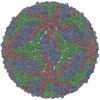
|
| 2 |
|
| 3 | x 5
|
| 4 | x 6
|
| 5 | 
|
| Symmetry | Point symmetry: (Schoenflies symbol: I (icosahedral)) |
- Components
Components
-Protein , 2 types, 6 molecules ABCabc
| #1: Protein | Mass: 54272.578 Da / Num. of mol.: 3 / Fragment: UNP residues 281-775 Source method: isolated from a genetically manipulated source Source: (gene. exp.)  Dengue virus 2 / Strain: ET200 / Cell line (production host): C6/36 / Production host: Dengue virus 2 / Strain: ET200 / Cell line (production host): C6/36 / Production host:  #2: Protein | Mass: 8384.814 Da / Num. of mol.: 3 / Fragment: UNP residues 206-280 Source method: isolated from a genetically manipulated source Source: (gene. exp.)  Dengue virus 2 / Strain: ET300 / Cell line (production host): C6/36 / Production host: Dengue virus 2 / Strain: ET300 / Cell line (production host): C6/36 / Production host:  |
|---|
-Sugars , 1 types, 6 molecules 
| #3: Sugar | ChemComp-NAG / |
|---|
-Non-polymers , 3 types, 460 molecules 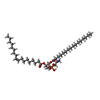




| #4: Chemical | | #5: Chemical | #6: Water | ChemComp-HOH / | |
|---|
-Details
| Has ligand of interest | Y |
|---|---|
| Has protein modification | Y |
-Experimental details
-Experiment
| Experiment | Method: ELECTRON MICROSCOPY |
|---|---|
| EM experiment | Aggregation state: PARTICLE / 3D reconstruction method: single particle reconstruction |
- Sample preparation
Sample preparation
| Component |
| |||||||||||||||||||||
|---|---|---|---|---|---|---|---|---|---|---|---|---|---|---|---|---|---|---|---|---|---|---|
| Molecular weight |
| |||||||||||||||||||||
| Source (natural) |
| |||||||||||||||||||||
| Source (recombinant) | Organism:  | |||||||||||||||||||||
| Details of virus | Empty: NO / Enveloped: YES / Isolate: SPECIES / Type: VIRION | |||||||||||||||||||||
| Natural host | Organism: Ochlerotatus normanensis | |||||||||||||||||||||
| Virus shell | Diameter: 470 nm / Triangulation number (T number): 3 | |||||||||||||||||||||
| Buffer solution | pH: 8 | |||||||||||||||||||||
| Buffer component |
| |||||||||||||||||||||
| Specimen | Conc.: 7.7 mg/ml / Embedding applied: NO / Shadowing applied: NO / Staining applied: NO / Vitrification applied: YES | |||||||||||||||||||||
| Specimen support | Grid material: COPPER / Grid mesh size: 300 divisions/in. / Grid type: Quantifoil R1.2/1.3 | |||||||||||||||||||||
| Vitrification | Instrument: FEI VITROBOT MARK IV / Cryogen name: ETHANE / Humidity: 100 % / Chamber temperature: 277 K Details: 0 second wait time, 2.5 second blot time, -2 blot force, 1 second drain time |
- Electron microscopy imaging
Electron microscopy imaging
| Experimental equipment |  Model: Titan Krios / Image courtesy: FEI Company |
|---|---|
| Microscopy | Model: FEI TITAN KRIOS |
| Electron gun | Electron source:  FIELD EMISSION GUN / Accelerating voltage: 300 kV / Illumination mode: FLOOD BEAM FIELD EMISSION GUN / Accelerating voltage: 300 kV / Illumination mode: FLOOD BEAM |
| Electron lens | Mode: BRIGHT FIELD / Calibrated magnification: 130000 X / Calibrated defocus min: 300 nm / Calibrated defocus max: 2000 nm / Cs: 2.7 mm |
| Specimen holder | Cryogen: NITROGEN / Specimen holder model: FEI TITAN KRIOS AUTOGRID HOLDER |
| Image recording | Average exposure time: 12.5 sec. / Electron dose: 67.7 e/Å2 / Detector mode: SUPER-RESOLUTION / Film or detector model: GATAN K2 QUANTUM (4k x 4k) / Num. of grids imaged: 1 / Num. of real images: 4722 |
| Image scans | Movie frames/image: 50 / Used frames/image: 1-50 |
- Processing
Processing
| EM software |
| ||||||||||||||||||||||||||||||||
|---|---|---|---|---|---|---|---|---|---|---|---|---|---|---|---|---|---|---|---|---|---|---|---|---|---|---|---|---|---|---|---|---|---|
| CTF correction | Type: PHASE FLIPPING AND AMPLITUDE CORRECTION | ||||||||||||||||||||||||||||||||
| Particle selection | Num. of particles selected: 196292 | ||||||||||||||||||||||||||||||||
| Symmetry | Point symmetry: I (icosahedral) | ||||||||||||||||||||||||||||||||
| 3D reconstruction | Resolution: 2.5 Å / Resolution method: FSC 0.143 CUT-OFF / Num. of particles: 111223 / Algorithm: BACK PROJECTION / Num. of class averages: 1 / Symmetry type: POINT | ||||||||||||||||||||||||||||||||
| Atomic model building | Protocol: RIGID BODY FIT / Space: REAL | ||||||||||||||||||||||||||||||||
| Atomic model building | PDB-ID: 6CO8 Accession code: 6CO8 / Source name: PDB / Type: experimental model |
 Movie
Movie Controller
Controller





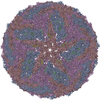
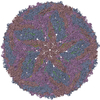
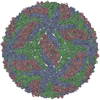
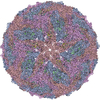
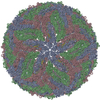
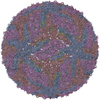
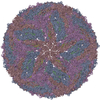
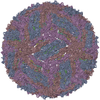
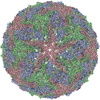

 PDBj
PDBj





